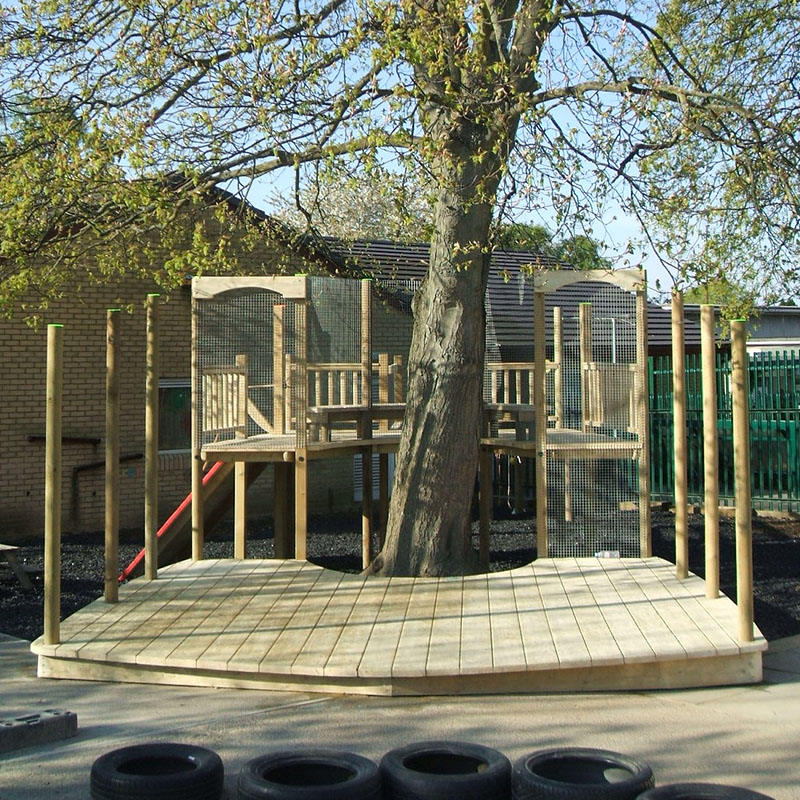Play Naturally, Thrive Uniquely: Encouraging Social Interaction

In the first part of our multi-part article on the magic and benefits of natural playgrounds we introduced the ‘Natural Playgound’. In the second, child development, physical activities and motor skills. Our third part, how natural playspaces encourage social interaction.
Now we’re taking a look at the design and features.
Natural playgrounds are thoughtfully designed and carefully planned to create engaging and enriching environments for children. These playgrounds incorporate a variety of natural elements and thoughtfully designed structures to provide sensory-rich experiences and promote healthy child development. In this section, we will explore the incorporation of natural elements like sand, water, rocks, and plants, typical structures and equipment found in natural playgrounds, and the importance of creating safe and stimulating environments for children’s well-being.
Incorporation of Natural Elements like Sand, Water, Rocks, and Plants
Natural playgrounds are thoughtfully designed to incorporate a diverse range of natural elements that provide sensory-rich experiences for children. These elements engage multiple senses and offer opportunities for exploration, creativity, and imaginative play. Some common natural elements found in natural playgrounds include:
- Sand: Sand play areas are a staple in natural playgrounds. They provide children with a tactile experience, allowing them to dig, build sandcastles, and create imaginary landscapes. Sand offers endless possibilities for sensory play, encouraging children to use their hands and imagination.
- Water: Water features are another prominent element in natural playgrounds. They can include streams, water tables, or small waterfalls. Water play offers children opportunities for sensory exploration, learning about water flow, buoyancy, and cause-and-effect relationships. It stimulates their curiosity, promotes experimentation, and provides a refreshing sensory experience.
- Rocks and Boulders: Natural playgrounds often incorporate rocks and boulders of various sizes, shapes, and textures. These elements serve as climbing structures, stepping stones, and balancing opportunities. They provide children with challenges that promote balance, coordination, and physical strength. Rocks and boulders also contribute to the aesthetic appeal of the playground, creating a natural and visually stimulating environment.
- Plants and Greenery: Natural playgrounds incorporate vegetation and greenery to create a connection with nature. Trees, shrubs, and other plantings add visual appeal and provide shade and natural boundaries. They contribute to the overall biodiversity of the space, attracting birds, insects, and other wildlife. Plants offer children opportunities to learn about the natural environment, observe growth and change, and engage in sensory experiences like smelling flowers or feeling different textures of leaves.
Typical Structures and Equipment Found in Natural Playgrounds
While natural playgrounds emphasize the use of natural elements, they may also include carefully designed structures and equipment that complement the natural environment. These structures are usually made of wood or other natural materials to blend harmoniously with the surroundings. Some typical structures and equipment found in natural playgrounds include:
- Wooden Play Structures: Natural playgrounds often feature wooden play structures that mimic the forms found in nature. These structures can include climbing frames, balance beams, platforms, and bridges. They provide opportunities for children to challenge themselves physically, develop coordination and balance, and engage in imaginative play scenarios.
- Rope and Net Structures: Rope bridges, net climbers, and hammocks are common features in natural playgrounds. They offer unique play experiences and opportunities for climbing, swinging, and imaginative play. These structures allow children to develop upper body strength, balance, and spatial awareness while fostering a sense of adventure and exploration.
- Treehouses and Lookout Points: Treehouses and lookout points are popular additions to natural playgrounds, providing elevated spaces for children to climb, observe their surroundings, and engage in imaginative play. They offer a sense of adventure, encourage problem-solving skills, and provide a unique vantage point for exploring the natural environment.
- Slides and Swings: Although natural playgrounds prioritize natural elements, they may still include traditional play equipment like slides and swings. However, these elements are designed to blend seamlessly into the natural surroundings, often incorporating natural materials such as wooden frames or ropes.
Creating Safe and Stimulating Environments for Healthy Child Development
Designing natural playgrounds involves careful consideration of safety, accessibility, and providing a stimulating environment for healthy child development. Safety measures are incorporated into the design, such as ensuring appropriate fall surfaces under climbing structures, avoiding sharp edges or protrusions, and maintaining proper maintenance and inspection protocols.
Furthermore, natural playgrounds prioritize creating stimulating environments that promote healthy child development. The design aims to engage children’s senses, encourage exploration, and provide opportunities for physical, cognitive, and social growth. The following aspects contribute to the creation of safe and stimulating natural playgrounds:
- Varied Terrain: Natural playgrounds often feature diverse terrain, including gentle slopes, hills, and uneven surfaces. This natural topography offers children opportunities to navigate different levels and challenges, improving their balance, coordination, and spatial awareness.
- Sensory Experiences: The incorporation of natural elements like sand, water, rocks, and plants provides rich sensory experiences. Children can feel the texture of sand, hear the sound of water, touch different surfaces, and experience the scents and colors of various plants. These sensory stimulations contribute to cognitive development, sensory integration, and creativity.
- Imaginative Play Areas: Natural playgrounds create spaces that inspire imaginative play. They may include designated areas such as playhouses, fairy gardens, or storytelling circles. These spaces encourage children to engage in pretend play, role-playing, and storytelling, fostering their creativity, language development, and social skills.
- Nature Trails and Discovery Zones: Natural playgrounds often incorporate nature trails and discovery zones where children can explore the natural environment. These areas may have signage or interpretive displays that provide information about local flora and fauna, encouraging learning and environmental awareness.
- Inclusive Design: Consideration for inclusivity is an important aspect of natural playground design. Ensuring that the playground is accessible to children of all abilities promotes inclusivity and allows for equitable play experiences. The design may include wheelchair-accessible pathways, inclusive play equipment, and sensory-rich features that cater to diverse needs.
Creating a safe and stimulating natural playground involves careful planning, collaboration with landscape architects and designers, and adherence to safety standards. It requires thoughtful consideration of the natural elements, play features, and the overall layout to maximize the benefits and ensure an enriching play experience for all children.
In conclusion, the design of natural playgrounds incorporates a variety of natural elements, structures, and features that provide sensory-rich experiences, promote imaginative play, and create safe and stimulating environments for healthy child development. The thoughtful integration of natural elements with carefully designed structures ensures that children can engage with nature, explore their surroundings, and enjoy diverse play opportunities that contribute to their physical, cognitive, and social growth.
Increasing Popularity and Future Trends
The increasing popularity of natural playgrounds reflects a growing recognition of their value in supporting children’s development and fostering a connection with nature. In this section, we will explore the reasons behind the rising interest in natural playgrounds, including their health benefits, developmental advantages, and environmental consciousness. We will also discuss potential future developments and innovations in natural playground design, such as the integration of technology, sustainable design practices, and a focus on inclusivity.
Growing Interest in Natural Playgrounds
n recent years, there has been a significant increase in interest and recognition of the value of natural playgrounds. Parents, educators, and professionals in child development are increasingly seeking out natural play environments for children. This growing interest is driven by a greater awareness of the benefits that natural playgrounds offer in terms of physical, cognitive, social, and emotional development.
Reasons for the Increasing Popularity of Natural Playgrounds Several factors contribute to the rising popularity of natural playgrounds:
- Health and Well-being: Parents and caregivers are recognizing the importance of providing children with opportunities to engage with nature for their overall health and well-being. Natural playgrounds offer a way to incorporate nature into children’s play experiences, promoting a healthier and more balanced lifestyle.
- Developmental Benefits: The unique benefits of natural playgrounds, such as promoting physical activity, fostering creativity and imagination, enhancing cognitive development, reducing stress, and encouraging social interaction, are increasingly recognized and valued. Parents and educators seek out natural playgrounds as a means to support children’s holistic development.
- Environmental Consciousness: As environmental awareness grows, there is a greater emphasis on connecting children with nature and instilling a sense of environmental responsibility from an early age. Natural playgrounds provide an opportunity for children to develop a deeper appreciation and understanding of the natural world, fostering a lifelong connection to nature.
Potential Future Developments and Innovations in Natural Playground Design
The field of natural playground design continues to evolve, and there are exciting possibilities for future developments and innovations. Some potential trends and advancements include:
- Integration of Technology: Future natural playgrounds may incorporate technology in creative and educational ways, such as interactive displays that provide information about local flora and fauna or augmented reality experiences that enhance children’s engagement with nature.
- Sustainable Design: As sustainability becomes increasingly important, natural playgrounds may focus on eco-friendly design elements. This could include the use of recycled materials, water-saving features, and energy-efficient components to minimize the environmental impact of playground construction and operation.
- Inclusive Design: Future natural playgrounds may place greater emphasis on inclusivity, ensuring that children of all abilities can fully participate and enjoy the play experience. This may involve incorporating universal design principles, accessible pathways, and inclusive play equipment that accommodates diverse needs.
Conclusion
Summary of the Benefits of Natural Playgrounds for Children’s Lives
Natural playgrounds offer a multitude of benefits for children’s physical, cognitive, social, and emotional development. They promote physical activity, foster creativity and imagination, enhance cognitive skills, reduce stress and anxiety, encourage social interaction, and provide opportunities for children to connect with nature.
Call to Action for Promoting and Supporting Natural Playground Initiatives
To maximize the benefits of natural playgrounds, it is crucial to promote and support their implementation in communities, schools, and public spaces. This can be done through advocacy efforts, collaboration with policymakers and urban planners, and the involvement of parents and educators in supporting the creation and maintenance of natural play environments.
Final Thoughts on the Significance of Connecting Children with Nature
Natural playgrounds play a vital role in reconnecting children with the natural world, fostering a sense of wonder, and nurturing a lifelong appreciation for the environment. By providing children with opportunities to explore, discover, and learn through unstructured play in natural settings, we can contribute to their overall well-being, development, and the creation of a more sustainable future.
By embracing the benefits of natural playgrounds and promoting their integration into children’s lives, we can provide them with rich and meaningful play experiences that support their growth, creativity, and connection with the world around them.
So, this was our fourth and final part in a series of articles looking at natural playgrounds and play spaces and the benefits they bring. If you would like to discuss your upcoming project, please contact us. We’d love to discuss your natural playground or play space and help build it with you.
